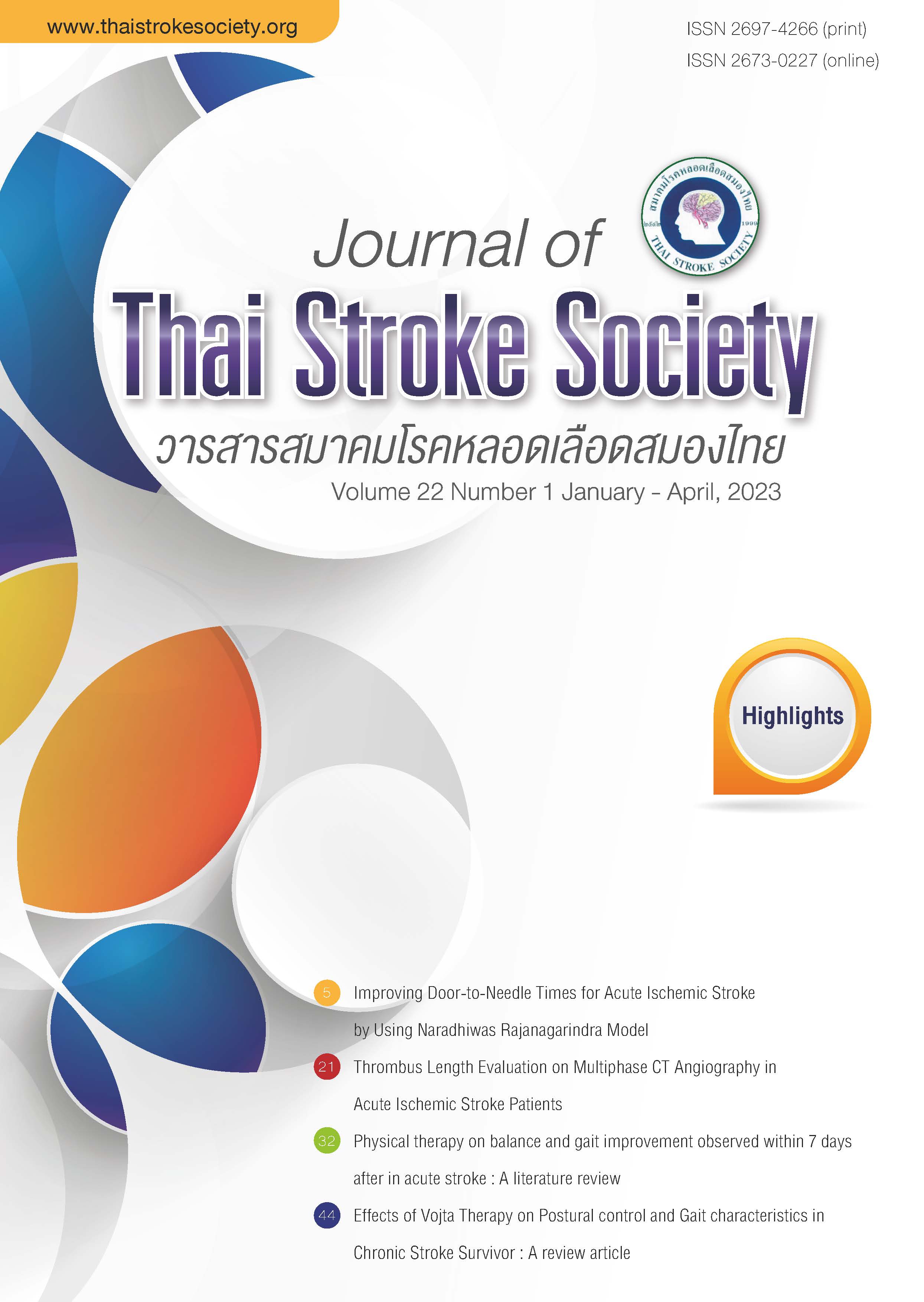Physical therapy on balance and gait improvement observed within 7 days after in acute stroke: A literature review
Keywords:
Physical therapy, Balance, Gait, Acute strokeAbstract
Physical therapy is essential for movement improvement for individuals with stroke, especially in acute phase. This review article focuses on physical therapy treatments and recommendations to guide the treatment of individuals with acute stroke during the first 7 days in the hospital. The form of training and exercise includes strength training exercises in both upper and lower extremities, bed mobility, task specific practice, sitting and standing balance training, and all forms of rehabilitation innovation. The effect of physical therapy rehabilitation improves balance and gait function due to the improvement of motor and sensory systems, promoting neural plasticity, enhancing motor learning and motor control, and preventing secondary complications that may occur before hospital discharge. However, physical therapy treatment may be limited to individuals with stroke whose medical status is unstable. Therefore, clinical status is crucial and should be evaluated in individuals with stroke prior to receiving physical therapy treatment.
References
Dharmasaroja PA, Ratanakorn D, Nidhinandana S, Ayudhaya SSN, Churojana A, Suwatcharangkoon S, et al. Thai guidelines of endovascular treatment in patients with acute ischemic stroke. J Thai Stroke Soc. 2019;18(2):53-75.
Khumros W, Ekpreechaku T. Cerebrovascular disease, risk faction, and quality of life: A systematic review. Chula Med Bull. 2019;1(5):473-487.
Chantkran W, Chaisakul J, Rangsin R, Mungthin M, Sakboonyarat B. Prevalence of and factors associated with stroke in hypertensive patients inThailand from 2014 to 2018: A nationwide cross‑sectional study. Sci Rep. 2021;11:17614.
Tepsimanon N, Khoynueng S. Effects of balance training on balance in patients with stroke Suratthani Hospital. Region 11 Medical Journal. 2018;32:1165-1174.
Sundseth A, Thommessen B, Rønning OM. Early mobilization after acute stroke. J Stroke Cerebrovasc Dis. 2014;496-499.
Hamre C, Fure B, Helbosted JL, Wyller TB, Hansen HI, Vlachos G. Balance and gait after first minor ischemic stroke in people 70 years of age or younger: A Prospective Observational Cohort Study. Phys Ther. 2020;100(5):798-806.
Bernhardt J. Very early mobilization following acute stroke: Controversies, the unknowns, and a way forward. Ann Indian Acad Neurol. 2008;11:88-98.
Cramer SC, Wolf SL, Adams SP, Chen D, Dromerick AW, Dunning K, et al.Stroke Recovery and Rehabilitation Research Issues, Opportunities, and the National Institutes of Health StrokeNet. Stroke. 2017;48(3):813-819.
Grefkes C, Fink GR. Recovery from stroke: current concepts and future perspectives. Neurol Res Pract. 2020;16(2):17.
Coleman ER, Moudgal R, Lang K, Hyacinth HI, Awosika OO, Kissela BM, et al. Early rehabilitation after stroke: a Narrative review. CurrAtheroscler Rep. 2017;19(12):59.
Kitaji Y, Harashima H, Miyano S. Relationship between first mobilization following the onset of stroke and clinical outcomes in patients with ischemic stroke in the general ward of a hospital: A cohort study. PhyTher Res. 2020;23(2):209-215.
Chippala P, Sharma R. Effect of very early mobilisation on functional status in patients with acute stroke: a single-blind, randomized controlled trial. Clin Rehabil. 2016;30(7):669-75.
Bernhardt J, Langhorne P, Lindley RI. Efficacy and safety of very early mobilisation within 24h of stroke onset (AVERT): a randomised controlled trial. Lancet. 2015;386(9988):46-55.
Herisson F, Godard S, VolteauC, Blanc EL, Guillon B, Gaudron M. Early sitting in ischemic stroke patients (SEVEL): A randomized controlled trial. PLoS One. 2016;11(3).
Rose DK, Denmark L, Fox EJ, Clark DJ, Wludyka P. A backward walking training program to improve balance and mobility in acute stroke: A Pilot Randomized Controlled Trial. J Neurol Phys Ther. 2018;42(1):12-21.
Gjelsvik BEB, Hofstad S, Smedal T, Eide GE, Naess H, Skouen JS, et al. Balance and walking after three different models of stroke rehabilitation: early supported discharge in a day unit or at home, and traditional treatment (control). BMJ. 2014;4:4358.
Morreale M, Marchione P, Pili A, Lauta A, Castiglia SF, Spallone A, et al. Early versus delayed rehabilitation treatment in hemiplegic patients with ischemic stroke: proprioceptive or cognitive approach? Eur J Phys Rehabil Med. 2016;52(1):81–9.
Yen HC, Chen WS, Jeng JS, Luh JJ, Lee YY, Pan GS. Standard early rehabilitation and lower limb transcutaneous nerve or neuromuscular electrical stimulation in acute stroke patients: a randomized controlled pilot study. Clin Rehabil. 2019;33(8):1344–1354.
Oddsson LIE, Finkelstein MJ, Meissner S. Feasibility of early functional rehabilitation in acute stroke survivors using the Balance-Bed—a technology that emulates microgravity. Front Syst Neurosci.2015;9:83.
Lin RC, Chiang SL, Heitkemper MM, Weng SM, Lin CF, Yang FC, et al. Effectiveness of early rehabilitation combined with virtual reality training on muscle strength, mood state, and functional status in patients with acute stroke: A randomized controlled trial. Original Article. 2020;17(2):158-167.
Yokota C, Yamamoto Y,Kamada M, Nakai M, Nishimura K, Ando D, et al. Acute stroke rehabilitation for gait training with cyborg type robot hybridassistive limb: A pilot study. Journal of the Neurological Sciences. 2019;404:11-15.
Watanabe H, Marushima A, Kadone H, Ueno T, Shimizu Y, Kubota S, et al. Effects of gait treatment with a Single-Leg Hybrid Assistive Limb System after acute stroke: A non-randomized Clinical Trial. Front Neurosci. 2020;13:1389.
Park C, Oh-Park M, Bialek A, Friel K, Edwards D, You JSH. Abnormal synergistic gait mitigation in acute stroke using an innovative ankle–knee–hip interlimb humanoid robot: a preliminary randomized controlled trial. Scientific Reports. 2021;11(1):22823.
จารุกูลตรีไตรลักษณะ, ชุติมาชลายเดชะ, สุนีย์บวรสุนทรชัย, วนาลีกล่อมใจ, จตุพรสุทธิวงษ์, ผกามาศพิริยะประสาธน์และคณะ. ตำราการจัดการทางกายภาพบำบัดสำหรับผู้ป่วยทางระบบประสาท. พิมพ์ครั้งที่1.กรุงเทพมหานคร: บริษัทพริ้นเทอรี่จำกัด. 2563.
Pramodhyakul N, Yangngam O, Satjapibantham N, Keawtep P. Effect of balance training by smartphone visual feedback on standing balance in patients with stroke: pilot study. Thai J Phys Ther. 2017;39(1).
Li Z, Zhang X, Wang K, Wen J. Effects of early mobilization after acute stroke:A meta-analysis of randomized control trials. J Stroke Cerebrovasc Dis. 2018;27(5):1326-1337.
Downloads
Published
How to Cite
Issue
Section
License
Copyright (c) 2023 Journal of Thai Stroke Society

This work is licensed under a Creative Commons Attribution-NonCommercial-NoDerivatives 4.0 International License.
ข้อความภายในบทความที่ตีพิมพ์ในวารสารสมาคมโรคหลอดเลือดสมองไทยเล่มนี้ ตลอดจนความรับผิดชอบด้านเนื้อหาและการตรวจร่างบทความเป็นของผู้นิพนธ์ ไม่เกี่ยวข้องกับกองบรรณาธิการแต่อย่างใด การนำเนื้อหา ข้อความหรือข้อคิดเห็นของบทความไปเผยแพร่ ต้องได้รับอนุญาตจากกองบรรณาธิการอย่างเป็นลายลักษณ์อักษร ผลงานที่ได้รับการตีพิมพ์ในวารสารเล่มนี้ถือเป็นลิขสิทธิ์ของวารสาร





